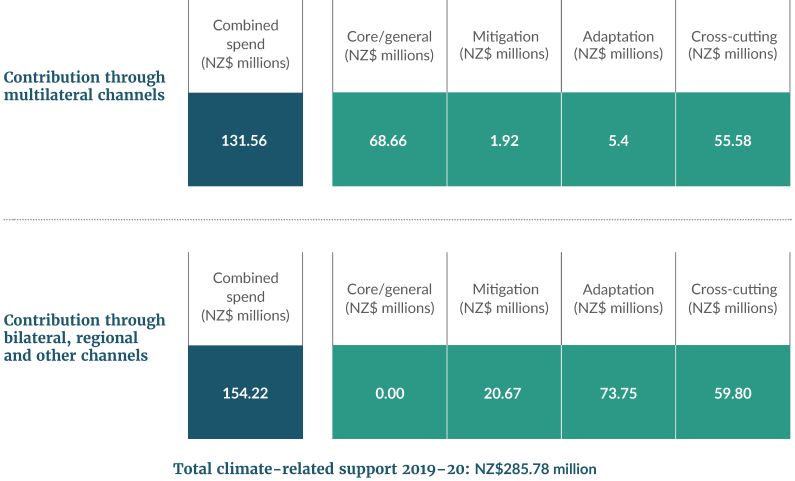This snapshot presents the key findings from New Zealand’s Eighth National Communication and Fifth Biennial Report to the United Nations Framework Convention on Climate Change.
This snapshot presents the key findings from New Zealand’s Eighth National Communication and Fifth Biennial Report to the United Nations Framework Convention on Climate Change.
Aotearoa New Zealand is already experiencing the impacts of a changed climate, and we will continue to experience changes into the future.
In the past 100 years, our climate has warmed by 1.1 degrees Celsius. We’re experiencing more hot days and fewer cold days, and 2021 was the warmest year on record. In the future, as projected changes such as sea-level rise, ocean warming, and increasing global temperatures continue to intensify, climate change impacts and risks are expected to escalate.
New Zealand has demonstrated its commitment to addressing these challenges by taking clear actions towards creating a low-emissions, productive, resilient, sustainable and inclusive economy. These actions will enable our communities and environment to prosper for generations to come.
We are committed to transparently reporting on how we are addressing climate change and how we are meeting our obligations and commitments. In these reports to the United Nations Framework Convention on Climate Change (UNFCCC), we detail our current emissions, as well as projections demonstrating the impact our policies and measures have on emissions reductions, adaptation action, and climate finance.
The reports also help to keep New Zealanders informed about our action on climate change, how we will meet our 2020 target, and other emissions information.
New Zealand’s Eighth National Communication is a detailed report on our actions to address climate change and is focused on developments since the Seventh National Communication. The Fifth Biennial Report covers a subset of the information. Both reports are required as part of New Zealand’s obligations under the UNFCCC.
Key points
- New Zealand's gross emissions are projected to decrease from 78.8 million tonnes of carbon dioxide equivalent (Mt CO2-e) in 2020 to 66.7 Mt CO2-e in 2035. The policies and measures we have put in place are important drivers behind decreases across the key emitting sectors.
- Net emissions are projected to increase from 55.5 Mt CO2-e in 2020 to 63.8 Mt CO2 -e in 2025, before decreasing to 41.2 Mt CO2-e in 2035. Forestry is a strong driver of this trend, as net emissions are influenced by planting and harvesting cycles.
- New Zealand's existing policies and measures are estimated to reduce net emissions by 30.7 Mt CO2-e in 2035, compared to taking no action.
- Both gross and net emissions are projected to be lower in 2035 than they were projected to be in the Fourth Biennial Report in 2019.
- New Zealand will meet its 2020 target to reduce gross greenhouse gas emissions to 5 per cent below 1990 levels (pending expert review), through emissions reductions, contributions from forestry activities and international units.
- We have made significant progress, and have put in place the framework to continue to cut emissions and build a climate-resilient future.
- New Zealand is committed to assisting developing countries to address climate change, and has committed NZ$1.3 billion in grant-based climate finance between 2022 and 2025.
New Zealand’s gross emissions are projected to decrease from 78.8 Mt CO2-e in 2020 to 66.7 Mt CO2‑e in 2035.
The policies and measures we have put in place are important drivers behind the decreases across the key emitting sectors.
New Zealand’s net emissions are projected to increase from 55.5 Mt CO2-e in 2020 to 63.8 Mt CO2-e in 2025, before decreasing to 41.2 Mt CO2-e in 2035.
Net emissions reported under the UNFCCC include emissions and removals of carbon dioxide from vegetation and soils across all land uses including forestry, grasslands and wetlands, and when land-use change occurs. Forests help remove carbon dioxide while growing, but can also release it, along with other greenhouse gases, through activities such as deforestation and harvesting, or natural disturbances.
New Zealand experienced planting spikes of production forests from the 1980s to the mid-1990s, so a relatively large proportion of our production forest estate is being, or has been, harvested and replanted in recent years. This is projected to continue until the late 2020s.
Figure 1: New Zealand’s historical and projected gross emissions and net emissions
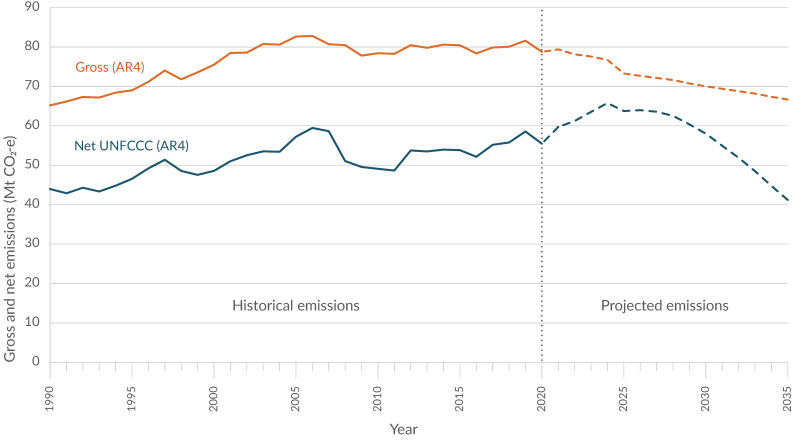
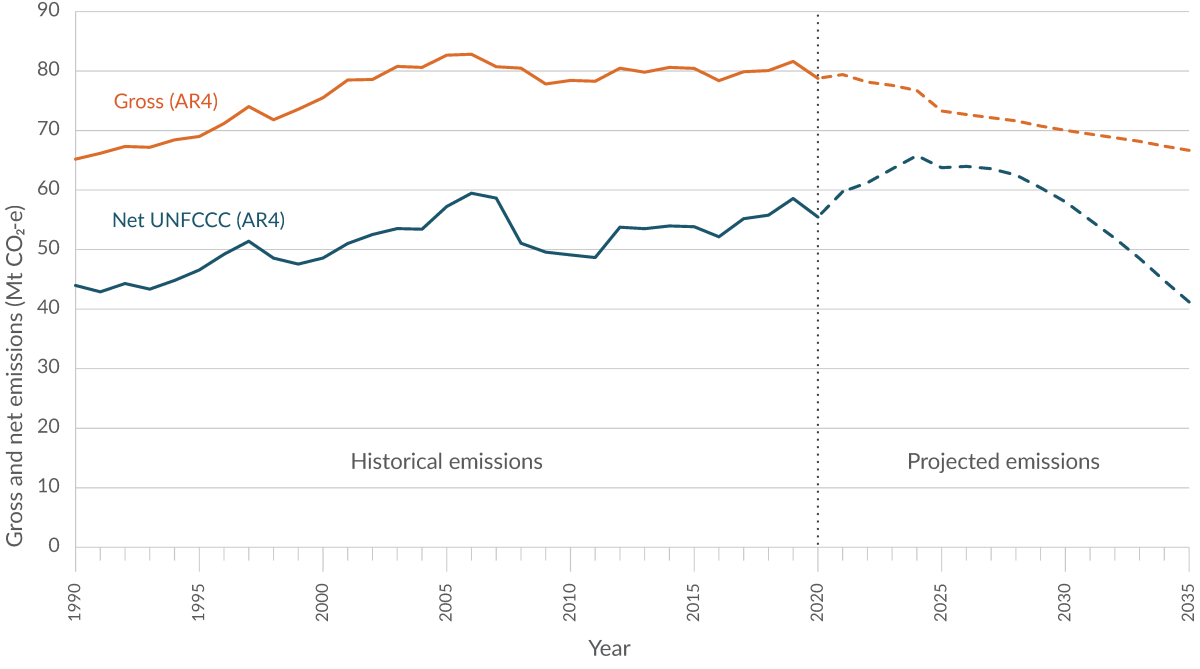
Our emissions are projected to be lower in 2035 than they were projected to be in New Zealand’s Fourth Biennial Report (BR4), published in 2019.
Gross emissions are projected to be 7.6 per cent lower in 2035 than they were projected to be in the BR4, primarily due to projected reductions in the energy and industrial processes sectors.
Net emissions are projected to be 28.8 per cent lower in 2035 than they were projected to be in the BR4.
We are unusual among developed countries in that our emissions are dominated by agriculture, which produced 50 per cent of our gross greenhouse gas emissions in 2020 (figure 2). The next largest sector is energy (including transport) which produced 40 per cent in 2020.
Emissions from agriculture are projected to decrease from 39.4 Mt CO2-e in 2020 to 35.3 Mt CO2-e in 2035. This is due to policies such as the New Zealand Emissions Trading Scheme, the Essential Freshwater package and the introduction of agricultural emissions pricing, as well as changes in farm management practices to improve environmental outcomes, a decline in stock numbers and ongoing improvements in animal productivity and on-farm efficiency.
Emissions from the energy sector are projected to decrease from 18.3 Mt CO2-e in 2020 to 11 Mt CO2-e in 2035, mainly due to the expected retirement of coal and gas-fired power plants which will be replaced by renewable generation such as wind and geothermal.
Emissions from transport were 13.2 Mt CO2-e in 2020, and are still increasing due to growing travel demand. They are expected to plateau at 15.1 Mt CO2-e in 2023, and then decline to 13.8 Mt CO2-e in 2035 due to uptake of electric vehicles and continued improvements in fuel efficiency.
Figure 2: New Zealand’s gross emissions profile in 2020
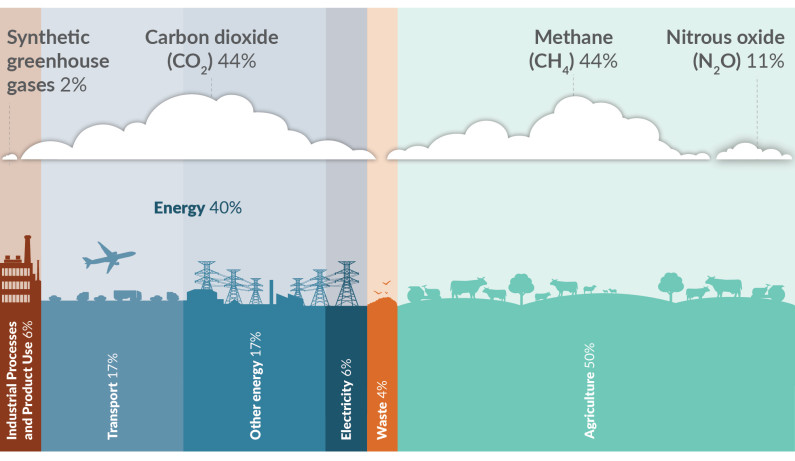
Different projection scenarios were modelled in these reports to project the effect of New Zealand’s quantifiable policies and measures out to 2035.
The projections show that New Zealand’s existing policies and measures are estimated to reduce net emissions by 30.7 Mt CO2-e in 2035, compared to taking no action.
Aotearoa New Zealand’s action on climate change
Aotearoa New Zealand has made significant progress and put policies and measures in place to help cut emissions and build a climate-resilient future.
In 2019, the Government amended the Climate Change Response Act to provide a framework for developing and implementing climate change policies that contribute to the global effort to limit the global average temperature increase to 1.5 degrees Celsius above pre-industrial levels.
This included setting up He Pou a Rangi – Climate Change Commission, which provides independent expert advice and monitors and reviews progress on climate change matters.
The New Zealand Emissions Trading Scheme, the principal tool underpinning New Zealand’s domestic emissions reduction action, has been amended to strengthen its impact. By 2025, all sectors including agriculture will be covered by a pricing system.
The Carbon Neutral Government Programme was launched in 2020 to accelerate the reduction of emissions within the public sector. Also that year, the Government declared a climate emergency.
New Zealand updated its first Nationally Determined Contribution (NDC1) in 2021 to the more ambitious target of reducing net greenhouse gas emissions to 50 per cent below gross 2005 levels by 2030. New Zealand will continue to work both domestically and internationally to ensure we do our fair share to tackle and support action on climate change.
We have set a domestic target to reach net zero emissions of all greenhouse gases other than biogenic methane by 2050, and for biogenic methane emissions to reduce to 24 to 47 per cent below 2017 levels by 2050, including to 10 per cent below 2017 levels by 2030. The first three emissions budgets have also been set, as part of a series of interim targets that step us towards this 2050 target.
In 2022 we published our first emissions reduction plan to set out the policies and strategies to meet our first emissions budget, and ultimately the 2050 target.
This plan included an action to establish a platform for Māori climate action that embeds partnership and representation, supports Māori-led strategy and alignment, and activates kaupapa Māori (Māori approach or customary practice), and tangata Māori (Māori people) solutions.
We also published our first national adaptation plan in 2022 to set out the strategies, policies and proposals which will allow us to build a climate-resilient future.
We are investing in climate change research across transport, agriculture, forestry, energy, and sustainable urban development. This includes the establishment of a new Centre for Climate Action on Agricultural Emissions.
Supporting climate action in developing countries
New Zealand remains committed to assisting developing countries to address climate change. The Government contributed NZ$285.78 million in climate-related support for developing countries across 2019 and 2020 (figure 3), an increase of NZ$22.16 million compared with 2017 and 2018.
New Zealand delivers its international climate finance through activities in its International Development Cooperation Programme. Activities focus on agriculture, disaster prevention and preparedness, ecosystem strengthening, renewable energy and water security.
We have committed NZ$1.3 billion in grant-based climate finance between 2022 and 2025, to support developing countries and communities to build resilience to climate change as well as to contribute to keeping global warming to no more than 1.5 degrees Celsius.
Figure 3: New Zealand’s climate-related support, 2019 and 2020
New Zealand submits a Greenhouse Gas Inventory to the UNFCCC every year. Our 2022 submission includes an inventory of emissions and removals of greenhouse gases from 1990 to 2020.
New Zealand will meet its 2020 target to reduce gross greenhouse gas emissions to 5 per cent below 1990 levels, through emissions reductions, contributions from forestry activities and international units.
This will be confirmed once the UNFCCC expert review process of our Greenhouse Gas Inventory and our Biennial Report are completed.
Figure 4: New Zealand’s international and domestic emissions reductions targets
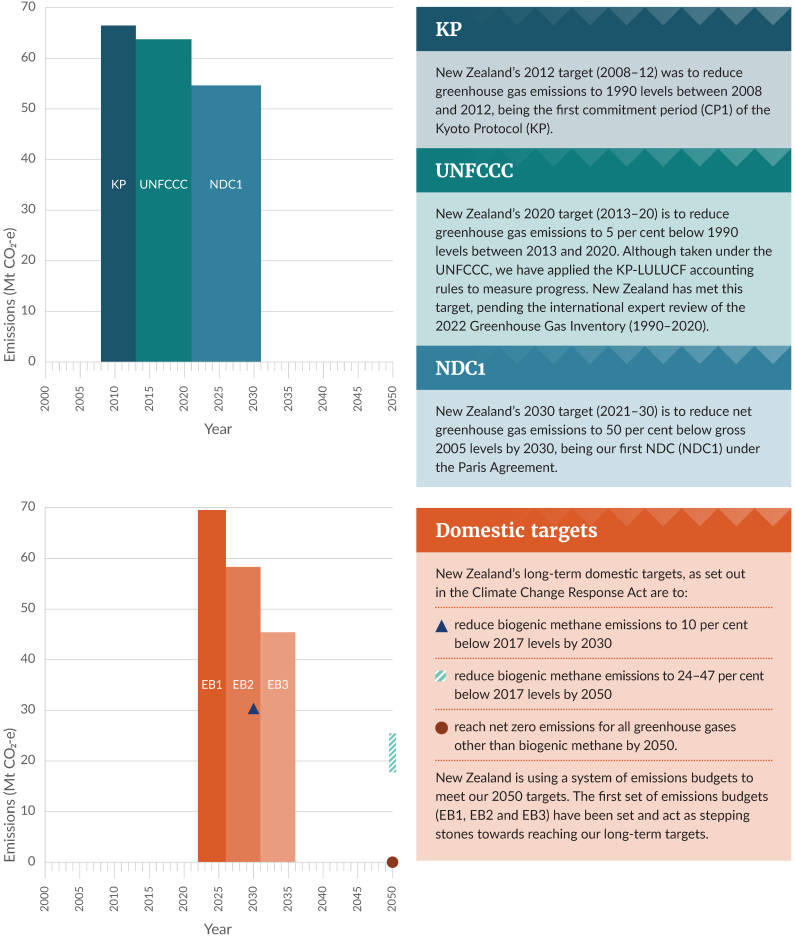
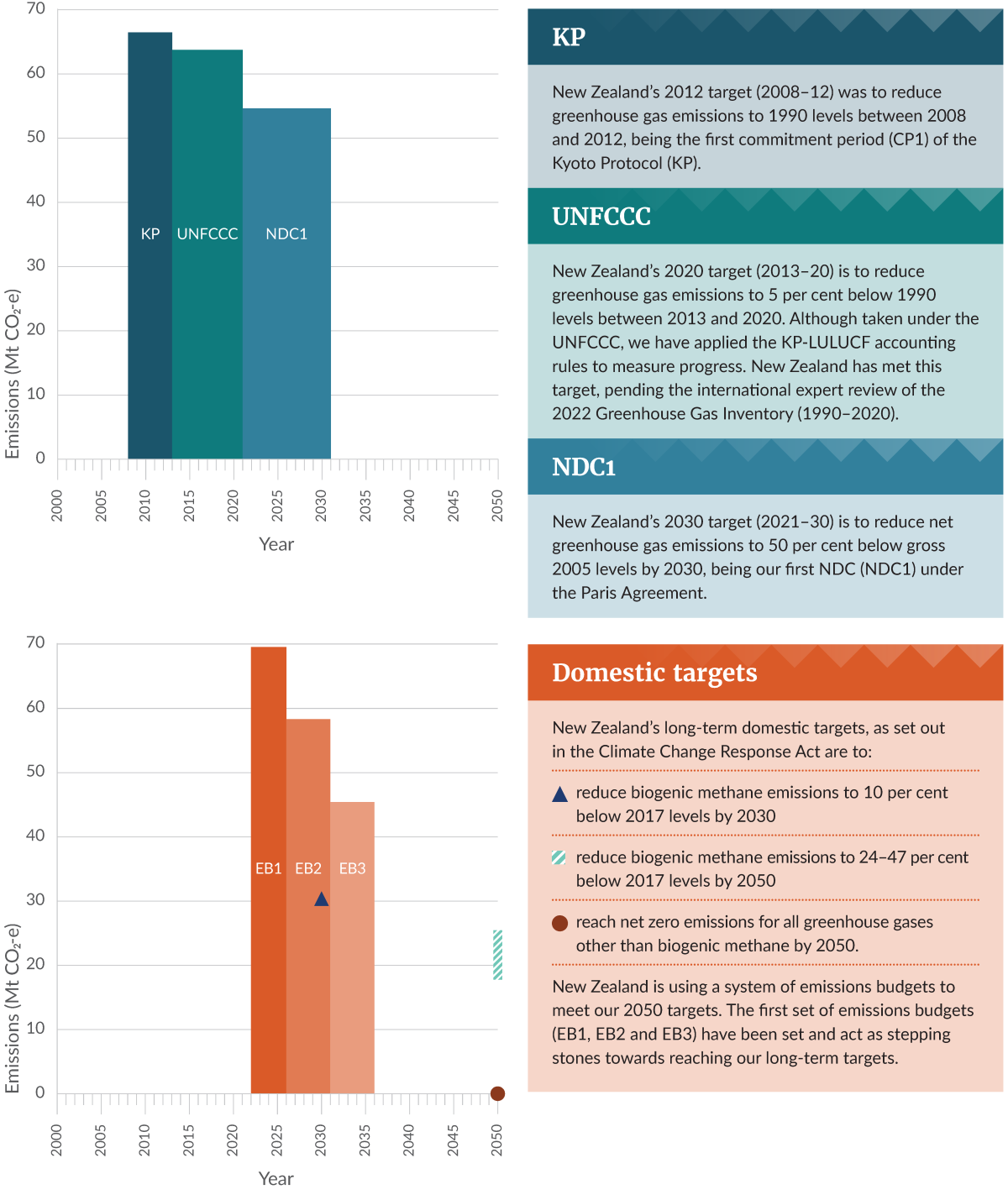
New Zealand intends to meet its next international target – the NDC1 under the Paris Agreement (figure 4) – through a combination of domestic emissions reductions, removal of carbon dioxide via sequestration sources such as forests, and participating in international carbon markets.
We will start reporting emissions for the NDC1 period in our Greenhouse Gas Inventory that will be published in April 2023. More information on progress towards the NDC1 will also be provided in the first Biennial Transparency Report under the Paris Agreement in 2024.
New Zealand has also set domestic emissions budgets to drive our transition to a low-emissions economy. They set decreasing limits on domestic emissions to ensure we are on track to meet our 2050 target under the Climate Change Response Act (figure 4). New Zealand set out its strategies and policies to meet the first emissions budget in the first emissions reduction plan.
The Ministry for the Environment thanks the following government agencies for their contribution to the production of New Zealand’s Eighth National Communication and the Fifth Biennial Report:
Department of Conservation, Department of Internal Affairs, Energy Efficiency and Conservation Authority, Environmental Protection Authority – Te Mana Rauhī Taiao, Ministry for Business, Innovation and Employment, Ministry for Foreign Affairs and Trade, Ministry for Primary Industries, Ministry of Housing and Urban Development, Ministry of Social Development, Ministry of Transport, National Institute of Water and Atmospheric Research, The Treasury, Waka Kotahi NZ Transport Agency.
See more on...
National Communication and Biennial Report 2022 snapshot
December 2022
© Ministry for the Environment
